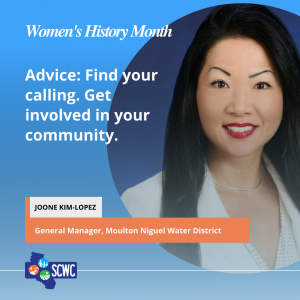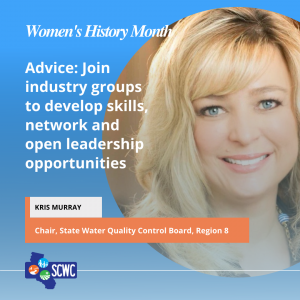We at the SCWC are celebrating and reflecting upon the dynamic, trailblazing women who contribute their leadership, collaboration, and expertise every day to creating a more resource-resilient future for Southern California.
In honor of Women’s History Month, we are spotlighting just a few of the regional female leaders whose service to public health and water supply reliability has proved instrumental in achieving strides towards sustainability. Their reflections on their careers, their support for one another, and their advice for other women pursuing a future in water are nothing short of inspiring. Each woman serves as a member of the Southern California Water Coalition Board of Trustees and several also chair or co-chair its task forces.
Patty Cortez
 Patty Cortez, Mayor Pro Tem for City of Covina, SCWC board member, and co-chair of the SCWC Legislative Task Force, encourages new professionals to learn as much as they can and not be afraid to ask questions. She reflected on moments at the beginning of her career when she was intimidated by others’ titles and expertise. “Over time, I found that the water industry is a very supportive community across all levels,” said Cortez. “I wish I had taken those early moments to ask questions and increase my knowledge in the field.”
Patty Cortez, Mayor Pro Tem for City of Covina, SCWC board member, and co-chair of the SCWC Legislative Task Force, encourages new professionals to learn as much as they can and not be afraid to ask questions. She reflected on moments at the beginning of her career when she was intimidated by others’ titles and expertise. “Over time, I found that the water industry is a very supportive community across all levels,” said Cortez. “I wish I had taken those early moments to ask questions and increase my knowledge in the field.”
Cortez herself brings tremendous expertise and experience that benefits the water field, including a background in public relations, work as a district staffer for a member of Congress, and public affairs and legislative project management for an energy utility.
“I truly believe every position I had prepared me to be where I am today,” said Cortez. “My background helped me realize that my passion was working in government and communicating to the public. Thankfully I have been fortunate enough to combine the two into my position today.”
Heather Dyer
Looking back on the beginning of her career, Heather Dyer, the CEO and general manager of the San Bernardino Valley Municipal Water District, never imagined that the top job at a water district was in her professional future. “I am an endangered species biologist by training,” said Dyer. “If I could give myself advice when I was new to the water industry, it would be to take off your blinders and let yourself imagine what is possible and what path you might take.”
Dyer discovered that her skill set was applicable across many aspects of her work throughout her career. “At the beginning, I never fully understood my ‘why.’ My why is complex problem solving to make the world a better place. I wish I had figured that out earlier.” She encourages young women just entering their field to figure out their “why,” too. “That will drive your future to do work that you love.”
Allison Febbo
For Allison Febbo, the general manager of the Mojave Water Agency, inspiration to pursue a career in water started with the female role models throughout her life. “I had a science teacher in high school who went out of her way to acknowledge and support my interest and abilities in the subject,” said Febbo, who also chairs SCWC’s Delta Issues Task Force. “And later, a college professor and scientist guided my development and was a great role model.” More recently, Febbo was encouraged by a colleague at the Mojave Water Agency. “Laura King Moon, the assistant general manager of State Water Contractors, made regular efforts to advise and support me through my career development,” added Febbo.
She considers herself fortunate to have been motivated by several influential women throughout her education and career and hopes to do the same for young women looking to enter the water industry today. “I would advise young women to expose themselves to as many networking, training, and leadership experiences as possible throughout their career, including finding a trusted mentor to help with guidance and advice,” said Febbo. “Find a comfortable work/life balance. We must develop and honor ourselves as whole individuals to make sustained contributions to water.”
Carol Lee Gonzales-Brady
Carol Lee Gonzales-Brady, the Board President of the Rancho California Water District and co-chair of SCWC’s Legislative Task Force, was inspired by prominent water rights attorney and Laguna Beach County Water District Commissioner Susan Trager to pursue and persist in her work in the water industry. “I had the honor and pleasure of counting her as a dear friend for years,” said Gonzales-Brady.
When one is just starting out in their career, it can be easy to get caught up with worries about what other people think. But the best advice that she’d give those starting out is to not to try too hard to please everyone. “There will always be those who may not like you or may even work against you for a variety of reasons,” said Gonzales-Brady. “But respect is more important than popularity, so make sure you focus on producing high-quality work.”
Sandra Kerl
Sandy Kerl, general manager of the San Diego County Water Authority and chair of SCWC’s Colorado River Task Force, found inspiration from a female water veteran of her district who pioneered innovation. “Maureen Stapleton, SDCWA’s retired general manager, helped to create water reliability through innovation and creativity in the San Diego region that had never been done before and is standing the test of time during this historic drought in California.” It’s these dynamic approaches that Kerl hopes to see more women bringing to the future of water.
As one who spent her entire career in public service, starting as an intern and working her way up, Kerl knows a thing or two about professional growth and development. “Avail yourself to all opportunities to learn and engage,” Kerl advised all newcomers to the water industry. “Seize opportunities to attend webinars, training, conferences, mentorships, and new assignments for which you will have to stretch to achieve the desired outcome.”
Joone Kim-Lopez
As a former police officer, Joone Kim-Lopez is unafraid to stand up for those who can’t speak for themselves. “I can’t sit by and see injustice,” said Kim-Lopez, who is now the general manager of the Moulton Niguel Water District. “I hope that women will be more impactful in establishing justice because when you talk about diversity and inclusion, what it comes down to is justice.” She hopes that her leadership will continue to inspire regional inclusion efforts and keep moving water in the direction of equity.
There were many women in water that Kim-Lopez looked up to when she entered the public leadership. “Environmentalist Frances Spivy-Weber, Orange County-based water leaders Cathy Green and Pam Tobin, and San Bernardino County-based water leader Kathy Tiegs all spoke up and stuck up for others,” said Kim-Lopez. “I admired that.” She went on to articulate her hope for the water industry’s future to include more perspectives from different backgrounds. “We have the ability to make things better for the people of California,” said Kim-Lopez. “Find your calling. Get involved in your community.”
Kris Murray 
Kris Murray, Chair of the Santa Ana Regional Water Quality Control Board and president of KLM Strategies, a women-owned consulting firm advancing sustainable projects, encourages women’s involvement in the water industry. “Women are still underrepresented despite many rewarding career paths within the water industry,” said Murray. She recommends that women entering the sector identify mentors to guide them and to join associations and industry groups that will help them develop their skills, broaden their contacts, and open opportunities for leadership.
“The future of water must include a comprehensive focus on the nexus between climate change, sustainability of our natural resources, water quality and supply,” said Murray, who also chairs SCWC’s Water Energy Efficiency Task Force. “I look forward to watching women in water innovate new ways to resolve these issues and secure the long-term resiliency of our industry.”
Janice Rutherford
Janice Rutherford, SCWC Board Chair and the Second District Supervisor of the County of San Bernardino, is continually inspired by women’s hard work, expertise, and contributions to the water sector. Her shoutout is to Debby Cherney, who served as the Eastern Municipal Water District’s Deputy General Manager.
“Debby impresses me with her work ethic as well as her desire to expand her knowledge of policy and government issues,” said Rutherford. “She is dedicated to helping other women succeed in their career paths, and I admire her commitment to excellence in public service.”
Kathy J. Tiegs
Kathy J. Tiegs, former SCWC Board Chair and longtime director of Cucamonga Valley Water District, was motivated by another strong leader in water. “Pat Mulroy, the retired general manager of Southern Nevada Water Authority, inspired me throughout my career,” said Tiegs. “In a male-dominated industry, she encouraged women to get involved in water issues and pursue leadership and elected positions. I am forever grateful to Ms. Mulroy for the example she set in blazing the path for women in the water industry.”
Tiegs also had a welcoming statement for young women entering the water industry. “You are the next generation of women water leaders to protect our most vital resource: water,” said Tiegs. “The water industry provides you with the opportunity to achieve your long-term goals, take on leadership roles, work with a diverse multidisciplinary group of professionals, meet interesting people, influence collaboration and outcomes, and most importantly, have your voice heard as more and more women get involved in water issues.”
Eunice Ulloa
Mayor Eunice Ulloa of the City of Chino grew up in the hub of the citrus and dairy industry, making her keenly aware of the importance of water from a young age. When she served as the executive director of the Chino Basin Water Conservation District, she was excited to see many young women entering the water industry.
Ulloa, who has served on the Chino City Council since 1984, recounted a time that she felt re-inspired by one of her hires: “I hired a young woman with a doctorate in Water Science and Management to lead our education programs. Her passion for her work, her knowledge and understanding of the science of water, and the art of educating others about water were infectious. Her energy and creativity in teaching students about water by getting them out in the field, experiencing the complexity firsthand, and passing along those skills to educators were exciting and inspiring. When she spoke, you could see lightbulbs turning on in the room. I think that for those of us who have been in the water industry a long time, it is important to look at the issues from new perspectives.”
